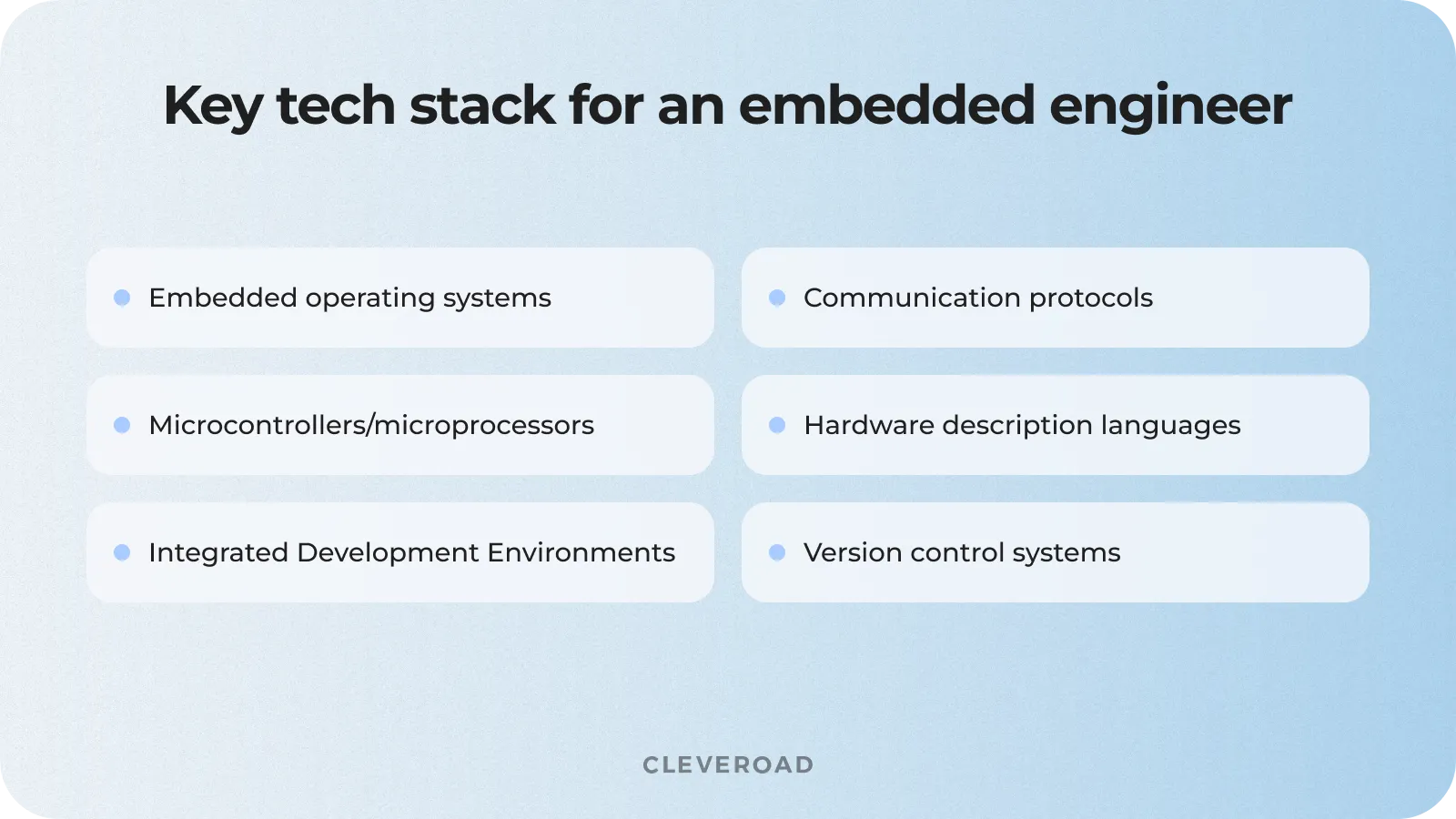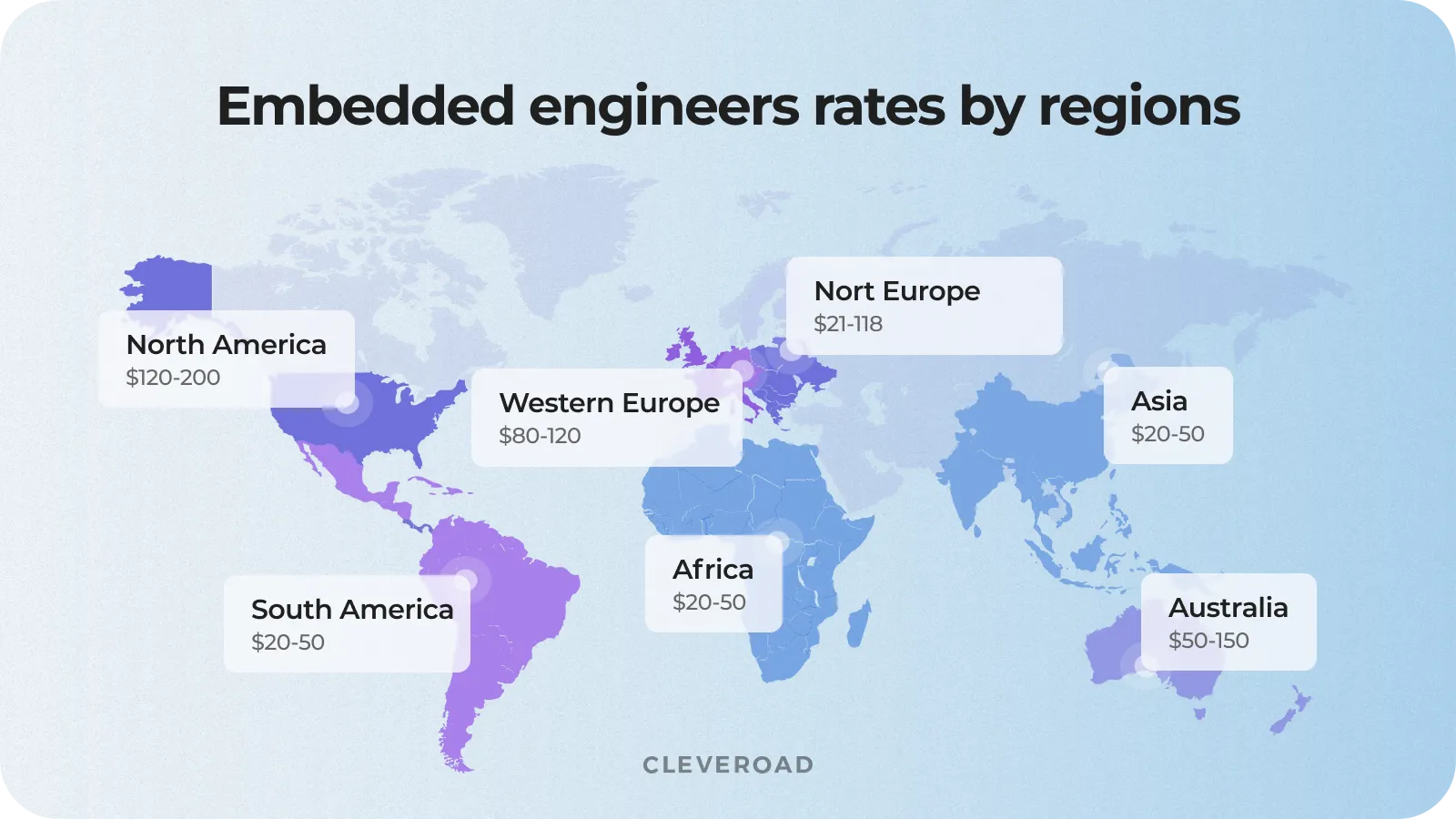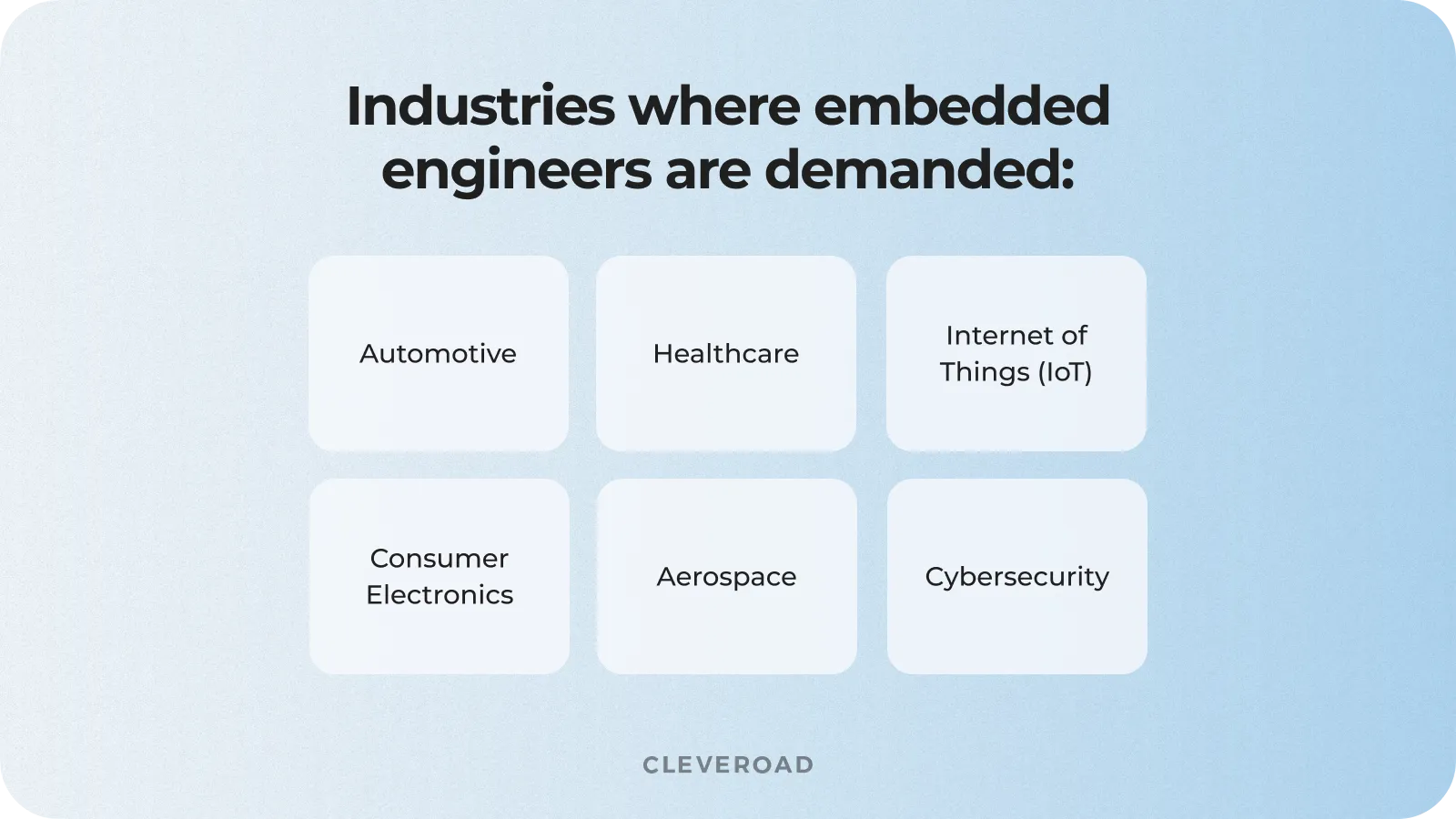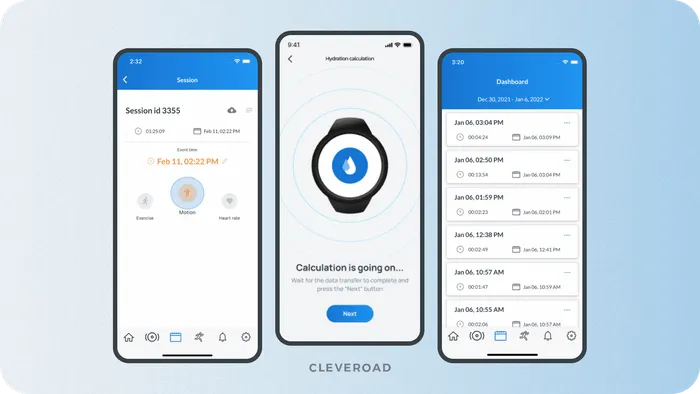Disclosing Ways to Hire Embedded Engineers in Our Full Guide
13 Jul 2023
12 Min
673 Views
The IT sector has tracked a thriving demand for embedded engineers, conditioned by the rising popularity of Internet of Things technologies across various sectors. The integration of smart devices and interconnected systems has opened up new opportunities and challenges, leading to the increasing need for experts in embedded systems development.
Within this guide, you will discover strategies to hire embedded engineers who possess the expertise required to elaborate your business.
Embedded Software Engineers: What Is All About?
Embedded software engineers possess an integral specialization in the development of embedded systems, which are computer systems designed to perform specific tasks within larger electronic devices or machinery.
Thus, the embedded engineer for hire is responsible for designing, developing, and maintaining the software that controls and operates these embedded systems. Their work often involves programming in low-level languages and optimizing code for efficiency and performance.
The primary responsibility of the embedded software engineer for hire is to write code that enables the embedded system to function according to its intended purpose. They are required to have a profound awareness of the hardware they are working with, as well as the specific needs and constraints of the embedded system. This e knowledge of microcontrollers, microprocessors, sensors, actuators, and other electronic components.

Embedded developer techstack
Here are some key skills and areas of responsibility for embedded software engineers:
- Programming languages. If you’re looking to hire embedded engineers, make sure they are sufficiently experienced in low-level languages such as C and C++, as such, a tech stack is commonly used for embedded system software development. Knowledge of assembly language may also be required for certain projects.
- Hardware understanding. Embedded engineers need to have a solid understanding of the underlying hardware architecture, covering microcontrollers, memory management, input/output interfaces, and communication protocols.
- Good knowledge of Real-Time Operating Systems (RTOS). Many embedded systems require real-time responsiveness, and engineers need to be familiar with RTOS concepts and programming techniques to meet timing requirements.
- Device drivers. They develop device drivers to interface with external hardware components, such as sensors, actuators, and communication modules.
- Work with embedded software development tools. Embedded engineers comprehend how to use various tools, such as integrated development environments (IDEs), debuggers, simulators, and emulators, to write, test, and debug their software.
- Performance optimization. Software streamlining is also a part of their responsibilities to ensure efficient utilization of system resources, such as memory, processing power, and energy consumption. This involves profiling, code refactoring, and employing algorithms for efficient data processing.
- Testing and debugging. Embedded software engineers are responsible for testing their code, verifying its functionality, and debugging any issues that arise during development or deployment.
- Security and safety. Depending on the application, embedded systems may require to hire embedded systems engineer to implement security measures or safety certifications. Engineers must be aware of potential vulnerabilities and design software accordingly.
The role of embedded software engineers is crucial in diverse niches, such as automotive, aerospace, healthcare, consumer electronics, industrial automation, and IoT. They work closely with hardware engineers, system architects, and other stakeholders to develop reliable, efficient, and robust embedded systems that meet specific requirements.
Steps to Hire an Embedded Engineer
Let’s observe an exemplary roadmap that discloses how to hire embedded software engineers:
Determine the goals of the business
The first step is to determine why your company needs to hire embedded software engineers. Clearly define what expertise and skills you are looking for in a developer and in which areas you want to apply them. This will help clarify your requirements and simplify the selection process. To illustrate, you may consider the following:
- Your aim for the employment
- Core technology required
- Additional technical and electronic skills
- Level of seniority
If you are lacking technical expertise, it may be challenging for you to assess the level of expertise of an embedded engineer for hire, so it is wise to engage an IT consultant to help you.
Consider engineer expertise
Evaluate the required level of experience and expertise of the embedded developer to successfully accomplish your tasks. The developer may have specialization in areas such as C/C++ programming, knowledge of hardware platforms, experience with microcontrollers, signal processing, and other specific areas.
Choose a collaborative model
You are able to choose among the four most popular partnership conditions when seeking to hire embedded developers:
- Freelance. The developer works on the project independently and temporarily. This can be a good option for small projects with specific deadlines.
- Internal collaborators (in-house). Hire a developer directly from your company. This can be useful if you have an ongoing need for the expertise of an embedded developer and the ability to provide them with a permanent job.
- Outsourcing. Hire an external company or team to handle the project. They will work on your tasks using their resources. This can be helpful if you don't have in-house resources or experience in embedded development.
- Outstaffing. Hire a developer through a company that provides outstaffing services, enriching your current expertise with a specialist profound in embedded engineering.
Working with embedded software outsourcing and outstaffing vendors offers the benefit of decreasing time and money on developer recruitment, as such providers already have pre-screened engineers in their talent pool. The same applies to outstaffing, via which you can hire experienced embedded engineers for specific project tasks without the need to assemble an in-house team. This flexibility allows you to leverage the expertise of skilled professionals without the overhead of building and maintaining a dedicated workforce.
Discover the IT outsourcing pros and cons in our utter guide
Best platforms to search for embedded developers
Below, we’ve compelled the list of the great platforms and resources to find embedded engineer for hire:
- Clutch is a business-to-business (B2B) ratings and reviews platform. It provides information and reviews on various service providers, including embedded systems developers. Clients can find highly rated companies and read client testimonials to make informed decisions to hire embedded engineers.
- LinkedIn is a popular professional networking platform with a vast user base of professionals from various industries, including embedded systems engineering. Recruiters can search for embedded developers based on their skills, experience, and location. LinkedIn also offers the option to message potential candidates directly.
- GitHub is a widely used platform for version control and collaborative software development. Many embedded systems engineers actively contribute to open-source projects on GitHub, showcasing their expertise. Recruiters can search for developers, review their repositories and contributions, and assess their skills and coding abilities.
- GoodFirms is an online directory that lists and evaluates IT service providers, including embedded systems developers. It provides comprehensive information about companies, including client reviews, portfolios, and rankings. Recruiters can use the platform to identify top embedded systems development companies.
Where to Hire Embedded Systems Engineers
Before starting the process of searching for embedded engineer for hire, you should be familiar with the most relevant platforms where technicians place their offers. Besides, you should get to know the approximate hourly rates which vary across regions to identify the relevant options for your business:
Popular tech hubs for hiring embedded systems engineers
You should consider the most popular tech hubs around the world. Let’s observe the regions where you can find proven expertise in embedded engineering:
Central & North Europe
- Estonia has a prosperous tech sector with a large pool of reliable tech vendors and a supportive business environment. Tallinn, the capital city of Estonia, is a significant tech hub and home to numerous tech companies, startups, and research institutions. The town offers a vibrant community to hire embedded engineers.
- Germany is known for its strong engineering culture and has a thriving tech industry. Berlin, Munich, and Hamburg are prominent tech hubs with a high concentration of embedded systems engineers. The country offers excellent research facilities and a well-developed ecosystem for hardware and software development.
- Sweden is recognized for its advanced technology sector and innovation-driven economy. Cities like Stockholm and Gothenburg have a robust embedded systems industry, attracting top talent. Sweden also boasts a favorable work-life balance and a supportive startup ecosystem.
- Poland has emerged as a key player in the European tech scene, with cities like Warsaw, Krakow, and Wroclaw hosting numerous tech companies. The country has a pool of skilled engineers specializing in embedded systems development, and it offers a cost-effective yet highly competitive talent market.
Western Europe
- The United Kingdom, in particular London, the capital of the UK, is a major global tech hub with diverse embedded engineer for hire options. The UK has a rich history of innovation and is home to numerous renowned universities and research institutions. Other cities like Cambridge, Bristol, and Manchester also have a significant presence of embedded systems engineers.
- France, especially Paris, has a flourishing tech ecosystem. The country invests heavily in research and development, and Paris is known for its strong engineering schools and research institutes. Lyon and Toulouse are also notable tech hubs with a focus on embedded systems and IoT development.
- The Netherlands is a thriving tech hub, with Amsterdam being the primary center for technology and innovation. The country has a well-developed infrastructure, a highly educated workforce, and a favorable business climate. Rotterdam and Eindhoven are also noteworthy tech cities attracting embedded systems talent.
Asia
- China has a rapidly growing tech industry and is a major hub for hardware and offers you a lot of options to hire embedded systems engineer. Considering Shenzhen, Beijing, and Shanghai, you can find offers of a vibrant tech ecosystem and access to a large pool of talented engineers. China's manufacturing capabilities and research institutes make it an attractive destination for embedded systems engineering.
- India has a strong presence in software development, but it is also emerging as a hub for embedded systems engineering. Bangalore, Hyderabad, and Pune have a burgeoning tech scene and host many multinational companies. India offers a vast talent pool, cost-effective solutions, and a rich engineering education system.
- Japan has a long-standing reputation for technological innovation and precision engineering. Tokyo, Osaka, and Yokohama are prominent tech cities with a focus on embedded systems. The country's well-established manufacturing industry and advanced research institutes contribute to a skilled workforce in this field.
South America
- Brazil has a growing tech industry and a flourishing startup ecosystem. Cities like São Paulo and Belo Horizonte have a significant presence of embedded systems engineers. Brazil's rich talent pool and favorable business environment make it an attractive destination to hire embedded developers.

Global rates of embedded engineers
Tips to Hire Embedded Software Engineers
Hiring embedded software engineers requires careful consideration and effective strategies to ensure successful recruitment. These are some tips and approaches that may simplify the process of finding an embedded engineer for hire:
- Practical experience and skills assessment. Look for candidates with relevant practical experience in embedded software development. Assess their technical skills, knowledge of programming languages (such as C/C++), familiarity with embedded systems platforms, and experience with relevant tools and frameworks. Conduct technical interviews, coding tests, or ask for project portfolios to evaluate their abilities.
- Cultural fit. Consider the cultural fit of the candidate within your organization. Embedded software engineers often work in close collaboration with cross-functional teams, so assessing their ability to work well within your company's culture, values, and team dynamics is essential. Look for candidates who demonstrate strong teamwork, adaptability, and communication skills.
- Adaptation process. Support the adaptation process of newly hired embedded software engineers. Provide them with necessary training and orientation about your company's work processes, tools, and methodologies. Assign mentors or team members to help them integrate smoothly into the team and provide guidance as they familiarize themselves with the project and company practices.
- Effective communication and transparency. Maintain effective communication channels with your embedded software engineers. Encourage open dialogue, active listening, and feedback exchange. Clear communication helps align expectations, clarify project requirements, and resolve issues promptly. Regular team meetings, stand-ups, and project management tools can facilitate efficient communication and transparency.
- Defining clear project requirements. Clearly define the requirements and goals of your project and the role of embedded engineer for hire. Provide detailed job descriptions and project specifications to potential candidates. This helps candidates understand the scope of work, technical challenges, and their responsibilities. It also enables them to assess their fit and interest in the project, leading to better alignment and engagement.
When organizing your hiring process, remember to customize it to suit your specific needs and align with your company culture. Don’t neglect to leverage technical assessments, interviews, and reference checks to evaluate candidates thoroughly. Additionally, consider the candidate's passion for embedded software development and their ability to learn and adapt to new technologies and industry trends continuously.

Embedded engineers industries
Why Hire Embedded Engineers at Cleveroad
At Cleveroad, you can hire embedded engineers who will bring vast experience and expertise in deploying embedded systems. As an established IT vendor with over 11+ years of experience in developing software solutions for businesses across diverse domains (Healthcare, E-commerce, FinTech, Logistics, Education, and even more), we are profound in delivering successful embedded projects.
Our embedded engineers possess a deep knowledge of hardware architecture, low-level programming languages, and real-time operating systems. We, at Cleveroad, have extensive experience in developing device drivers, optimizing software for resource-constrained environments, and ensuring the efficient performance of embedded systems.
Let us share one of our IoT cases to demonstrate which value you will be delivered by cooperating with Cleveroad team:
IoT-based system of human hydration monitoring in real-time
Our client is a scientific and commercial company based in the United States. They specialize in providing an IoT-based telecare solution designed for tracking human hydration levels. The company required tech vendors to:
- Create software that will enable users to monitor hydration indicators directly from their mobile devices
- Guarantee software compliance with the 510(k) FDA Medical Device Registration requirements for partnership programs with healthcare, sports, and wellness organizations
- Implementing a comprehensive software system that encompasses the business logic and hydration monitoring processes of the customer's solution, supported by IoT sensors
The Cleveroad team has delivered full-cycle development of a cross-platform Flutter application connected with an IoT hydration sensor. Our services covered creating a web-based Admin panel for user management and ensuring compliance with FDA requirements.
As a result, our customer received a refined app to replace the obsolete iOS solution. With it, the business customers are enabled to track hydration indicators from the IoT sensor. The Flutter app integrates into the customer's PaaS, synchronizing and storing sensor data, following FDA compliance.
Plan to build embedded systems?
Request a consultation on the integration of hardware and software to build such a solution
To effectively hire embedded engineers, clearly define job requirements, evaluate technical proficiency through tests and interviews, involve team members to assess cultural fit, and offer competitive compensation with professional development opportunities. Utilize diverse sourcing channels to attract qualified candidates and ensure a comprehensive evaluation process to select the best fit for your organization's embedded engineering needs.
By leveraging the skills and knowledge of embedded engineers, businesses can achieve seamless integration, optimize system performance, drive innovation, customize solutions, expedite time-to-market, and deliver high-performing products.
When evaluating candidates for embedded systems roles, consider technical skills in programming languages, firmware development, and debugging, industry/domain knowledge and project experience, problem-solving abilities, communication skills, and cultural fit with organizational values and work style.
Embedded engineers play a pivotal role in hardware-based system development, designing and developing hardware systems, integrating software and hardware components, and optimizing system performance through firmware code.

Evgeniy Altynpara is a CTO and member of the Forbes Councils’ community of tech professionals. He is an expert in software development and technological entrepreneurship and has 10+years of experience in digital transformation consulting in Healthcare, FinTech, Supply Chain and Logistics
Give us your impressions about this article
Give us your impressions about this article
